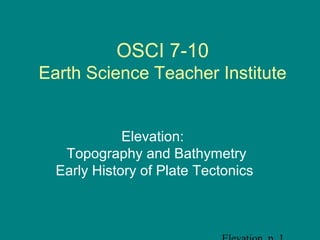This document provides an overview of the early history and development of the theory of plate tectonics. It discusses how early maps from Eratosthenes and Crates began to document topography and elevation patterns on Earth. In the late 1800s, scientists like Alexander von Humboldt, Antonio Snider-Pellegrini, and Edward Seuss began recognizing patterns in the shapes and fossil records of continents that suggested they were once joined together. In the early 1900s, scientists like Frank Taylor and Alfred Wegener proposed the first hypotheses of continental drift to explain these patterns, though Wegener's ideas faced skepticism at the time due to the unknown forces driving plate motions.





















![Continental Drift
• Wegener’s hypothesis of “continental drift”
– "Entstehung der Kontinente und Ozeane”
(The Origin of Continents and Oceans)
"It placed an easily comprehensible,
tremendously exciting structure of ideas upon a
solid foundation. It released the continents from
the Earth's core and transformed them into
icebergs of gneiss [granite] on a sea of basalt. It
let them float and drift, break apart and
converge. Where they broke away, cracks, rifts,
trenches remain; where they collided, ranges of
folded mountains appear.”
Hans Cloos](https://image.slidesharecdn.com/03topography-101130204525-phpapp01/85/What-is-Topography-22-320.jpg)

